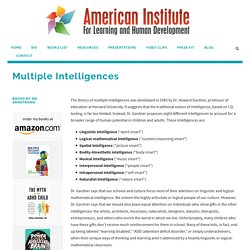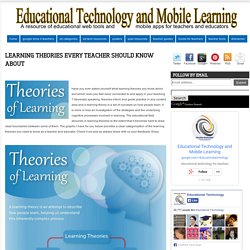

Multiple Intelligences and Learning Styles. Official Dunn & Dunn Online Assessments, Surveys & Community - Multiple Intelligences. Multiple Intelligences by Dr. Thomas Armstrong. The theory of multiple intelligences was developed in 1983 by Dr.

Howard Gardner, professor of education at Harvard University. It suggests that the traditional notion of intelligence, based on I.Q. testing, is far too limited. Instead, Dr. Gardner proposes eight different intelligences to account for a broader range of human potential in children and adults. These intelligences are: Linguistic intelligence (“word smart”)Logical-mathematical intelligence (“number/reasoning smart”)Spatial intelligence (“picture smart”)Bodily-Kinesthetic intelligence (“body smart”)Musical intelligence (“music smart”)Interpersonal intelligence (“people smart”)Intrapersonal intelligence (“self smart”)Naturalist intelligence (“nature smart”) Dr.
The theory of multiple intelligences proposes a major transformation in the way our schools are run. The theory of multiple intelligences also has strong implications for adult learning and development. How to Teach or Learn Anything 8 Different Ways Resources. Multiple Intelligences Self-Assessment. Multiple Intelligences: What Does the Research Say? Many educators have had the experience of not being able to reach some students until presenting the information in a completely different way or providing new options for student expression.

Perhaps it was a student who struggled with writing until the teacher provided the option to create a graphic story, which blossomed into a beautiful and complex narrative. Or maybe it was a student who just couldn't seem to grasp fractions, until he created them by separating oranges into slices. Because of these kinds of experiences, the theory of multiple intelligences resonates with many educators. It supports what we all know to be true: A one-size-fits-all approach to education will invariably leave some students behind. However, the theory is also often misunderstood, which can lead to it being used interchangeably with learning styles or applying it in ways that can limit student potential. Howard Gardner's Eight Intelligences The Difference Between Multiple Intelligences and Learning Styles. Learning Theories Every Teacher should Know about. Have you ever asked yourself what learning theories you know about and which ones you feel more connected to and apply in your teaching ?

Generally speaking, theories inform and guide practice in any content area and a learning theory is a set of concepts on how people learn. It is more or less an investigation of the strategies and the underlying cognitive processes involved in learning. The educational field abounds in learning theories to the extent that it becomes hard to draw clear boundaries between some of them. The graphic I have for you below provides a clear categorization of the learning theories you need to know as a teacher and educator. Check it out and as always share with us your feedback. Courtesy of edudemic.
Www.harding.edu/ARC/PDF/CITE.pdf. Pop Quiz! What Type Of Learner Are You? The Current State Of Technology In K-12 7.63K Views 0 Likes What is the next device most students will soon purchase? How many schools have a digital strategy? Find out in the current state of technology in K-12. 5 Reasons We Use Social Media 11.54K Views 0 Likes There are many reasons we use social media. Learning Styles and Learning Styles Inventories. Www.agelesslearner.com/dl/alcls011008.pdf. Free learning styles inventory (test, quiz or questionnaire), including graphical results.